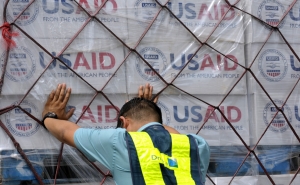The Ills of Pandemic Fatigue
As the U.S. crosses the one year mark of community transmission of COVID-19, expert Caitlin Rivers says it’s more important than ever to stay dedicated to public health practices

This article originally appeared on The Hub.
This month, the nation will mark the grim anniversary of the first confirmed cases of community spread of COVID-19 within the U.S. For nearly a year, the novel coronavirus SARS-CoV-2 has disrupted American lives in ways previously unexpected, and while vaccines have already reached millions of people, new virus variants also risk upending the progress public health and medical officials have made.
It’s all, frankly, exhausting. But pandemic fatigue is a social concern, because it causes people to cut corners on public health measures, putting themselves and others at risk.
“People are tired of making drastic changes to their everyday lives and forgoing things that are important to them like visiting family and doing activities,” says Caitlin Rivers, an assistant professor at the Johns Hopkins Bloomberg School of Public Health and a senior scholar at the Center for Health Security. “At some point, people slide a little bit in their devotion to public health measures.”
Rivers shared further insights into the phenomenon of pandemic fatigue and the risk it poses to Americans.
What are the risks of pandemic fatigue?
What we don't want is for people to start to incorporate more risky behaviors back into their lives before the public health conditions have improved. Right now, things are improving a lot, and we want to maintain that course. We started in mid-January at our all-time high of about 250,000 daily reported cases. Now we're down below 150,000 daily reported cases, which is great, but we really want to be down below a 100,000, below 50,000. And so we need to keep pushing in that direction.
Are there mindsets or habits that reinforce pandemic fatigue, such as believing that there will come a day where things are instantly back to normal or misconceptions about the effectiveness of vaccines?
I think that people want to keep themselves and their families safe. Right now, everyone is hearing about all of the things that they can't do. It’s important for people to also hear about things that are safe to do, to maintain options for people, so they can incorporate things that are important to them, but in a safe way.
Are there aspects of society that we should absolutely prioritize returning to normal or getting things back up and running?
The first that I would emphasize is schools. In many communities, children have not been in a classroom since last March. And it's been really hard. It's been hard on the kids. It's been hard on families. I do think that returning kids to the classroom safely needs to be one of our top societal priorities.
Another one I would emphasize for prioritization is visitation policies for hospitals and long-term care facilities, particularly in end of life situations. Sadly, many people are dying alone without loved ones at the bedside. And that is completely heartbreaking. Although it's understandable from an infection control perspective why we need to protect staff, visitors and other patients by limiting visitation policies, these are special cases. And so it would be nice to find a way forward to relax that policy.
And are there any indications of how long we can realistically expect to remain social distancing and masking?
You know, those two particular things, distancing and masking, are relatively easy to comply with and relatively cheap. And so I would propose that those will be with us for a while yet. But there will be other things that we will be able to reincorporate into our lives, because prevalence will fall as more people are vaccinated. I can see a world where we would be able to have more gatherings and more activities like sports and clubs in the summer. Those kinds of things might be able to come back, but we'll still need to take some sensible precautions like masks in order to make that possible.
Are there signs of hope in the current state of the pandemic?
Two big things. First, incidence is falling. The number of daily reported cases has come down a lot since mid-January and it's been a really encouraging trend. And so I'd like to see that continue. The other big thing is the vaccines. We have two authorized vaccines, probably at least one more on the way and that will be really helpful for keeping people protected. There is one curve ball, however, that I'm worried about, and that's the new variants that have emerged. That may throw us another challenge.
If you could share one public health message with the public, what would you say?
It’s been a long year, and I know that everyone is tired and really feeling the weight of this difficult time. Things will get better. We are on a better course, but it's up to us what happens next. And so we do need to continue to wear a mask, social distance, avoid gatherings. It is those individual choices, when put together, that will get us to a better place.
Caitlin Rivers, PhD, MPH, is a senior scholar at the Johns Hopkins Center for Health Security.



